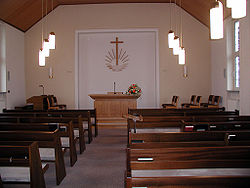New Apostolic Church
| New Apostolic Church (NAC) | |
|---|---|

New Apostolic church hall with emblem
|
|
| Classification | Chiliastic, partly Restorationist |
| Orientation | Irvingian movement, Christianity |
| Polity | Apostolic Hierarchical |
| Leader | Chief Apostle Jean-Luc Schneider |
| Distinct fellowships | International Apostles' Meeting District Apostles' Meeting Project Groups: -Faith Questions -Ecumenism -Music -Communication -Youth Committee for special affairs and others |
| Associations | Consortium of Christian Churches, Germany and Switzerland |
| Region | 181 nations, divided into 18 District Apostle areas, Int. headquarters: Zürich |
| Origin | 1863 Hamburg, Germany |
| Branched from | Catholic Apostolic Church |
| Separations |
Restored Apostolic Mission Church, Old Apostolic Church, United Apostolic Church, |
| Congregations | 59,816 (01/01/2016) |
| Members | 8,923,420 (01/01/2016) |
| Ministers | 256,812 (01/01/2016) |
| Aid organization | NAK karitativ, Germany |
| Official website | www.nak.org |
The New Apostolic Church (NAC) is a chiliastic church, originated from the Catholic Apostolic Church. The church has existed since 1863 in Germany and since 1897 in the Netherlands. It came about from the schism in Hamburg in 1863, when it demerged from the Catholic Apostolic Church, which itself started in the 1830s as a renewal movement in, among others, the Anglican Church and Church of Scotland.
Premillennialism and the Second Coming of Christ are at the forefront of the New Apostolic doctrines. Most of its doctrines are akin to mainstream Christianity and, especially its liturgy, to Protestantism, whereas its hierarchy and organisation could be compared with the Roman Catholic Church.
The church considers itself to be the re-established continuation of the Early Church and that its leaders are the successors of the twelve apostles. This doctrine resembles Restorationism in some aspects.
The official abbreviation in English-speaking countries is NAC (for New Apostolic Church), whereas it is NAK in German (Neuapostolische Kirche), ENA in French (Église Néo Apostolique), and INA in Portuguese (Igreja Nova Apostólica) and Spanish (Iglesia Nueva Apostólica).
In England in 1832, John Bate Cardale was called, through prophecies, as the first of the second sending. Eleven more men from various Christian denominations, social positions and religious training were called to the newly founded apostle ministry from then until 1835. After a long period of combined preparation, these apostles started to travel around the world, preaching the gospel of Jesus Christ. The main point of their gospel was that the Church had deviated from its origins; only through restoring the Universal Church to its perfect state could the return of Christ be ensured. They were convinced that the restoration of the apostles' ministry was necessary to achieve that perfect condition.
...
Wikipedia
